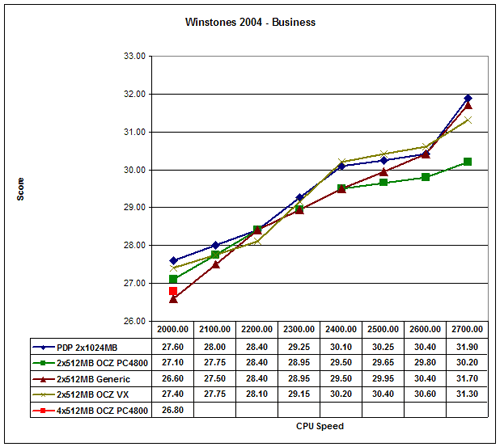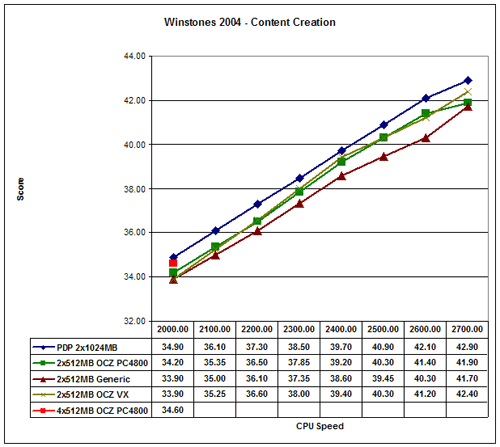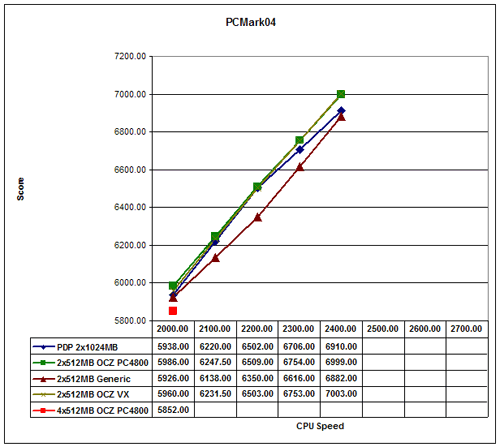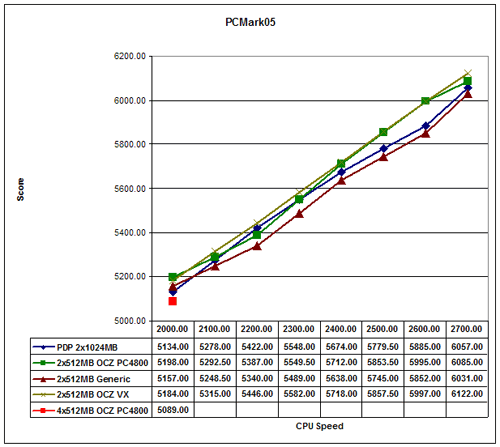Investigations into Athlon X2 Overclocking
by Jarred Walton on December 21, 2005 12:00 PM EST- Posted in
- CPUs
Application Performance
Moving on to more real-world applications, we'll start with Winstones 2004. Winstones run a bunch of scripts in a variety of applications. The problem is that many of the scripts simulate user input and operate at speeds no human can approach. Rendering an image, encoding audio or video, etc. can take time. Word, Excel, and Outlook, on the other hand, are almost entirely user-limited. While the fastest systems do perform higher, in every day use, the typical office applications are going to run so fast that differentiating between the various overclocked settings is difficult, if not impossible.
Normally (i.e. using the default settings), Winstones will defrag the hard drive, run through the script, reboot the system, and then start over. It does this five times, and the highest score is shown. Depending on your personal view, however, the reboot isn't really necessary. In fact, eliminating the reboot will generally result in higher scores on subsequent runs - a difference of as much as 15%. The Venice overclocking article allowed reboots to occur, but this time, I took that step out. The result is slightly higher scores compared to the Venice article, helped in part by the dual cores, but also by the removal of the reboots. The individual articles present comparable results, but you shouldn't directly compare the results. Honestly, Winstones isn't a terribly important measurement of performance anyway, but some people still worry about application performance.
We get a decent performance increase from overclocking, but nowhere near the theoretical maximum. If you look at single-core vs. dual core performance, it's also obvious that Winstones doesn't benefit much from the addition of a second core. That's understandable, as the tests are not done in a multitasking fashion, but newer multimedia applications should show more of a performance difference. Going from 2.0 GHz to 2.7 GHz represents a 35% CPU performance increase. In the Business Winstones test, we see a range from 26.6 to 31.9, a 20% increase. The Content Creation test gives a slightly larger increase, ranging from 33.9 to 42.9 - 27% more performance. Basically, what we're seeing is that Winstones really isn't completely CPU limited.
The different memory types also have very little impact on performance. Overall, the fastest RAM configuration ended up being the 2 GB set up, but only by a small percent - well within the margin of error for Winstones. The value memory is the slowest performer, which it should be given the lower price, but the difference isn't nearly as large as some people would expect. If you're going for a relatively expensive dual core processor, the results here aren't very conclusive. Still, if you need multitasking performance, more memory is a reasonable accessory.
Similar in some ways to Winstones performance, PCMark attempts to gauge system performance. The results are a little more theoretical, but the simulated applications are, in many instances, more recent and will benefit more from dual cores. PCMark also includes some 2D and 3D graphics tests, which make the GPU somewhat important to the overall score. If you compare results to those of the Venice article, you'll need to take the 7800GTX impact into consideration.
The difference between the slowest and fastest scores for our configuration is about the same as Winstones. PCMark04 goes from 5852 to 6999, a 20% increase. Unfortunately, PCMark04 was one application that consistently crashed at 2.4 GHz and above. Actually, crashed isn't the correct term; the grammar portion of the third multitasking test repeatedly failed. However, this is the only test that failed consistently above 2.4 GHz, so it's something of an anomaly. Everything appeared to run without issue, and we could get results for test 3 on its own, but we couldn't get the entire suite to complete. PCMark05 shows less of a difference, ranging from 5089 to 6101 (20%). PCMark05 also required the installation of the AMD CPU driver in order to produce acceptable scores. Without the driver installed, all HDD tests scored close to 0, severely impacting the results.
Both of the PCMark tests serve as great stress-tests of CPU overclocks, which is one of the reasons why we include the results. The issues with PCMark04 are difficult to explain, since in other testing, we have felt that PCMark05 was more strenuous. We did run all of the other tests in both PCMark products (scores not shown), and all of them passed. If we had encountered additional errors in either one, we would be more hesitant to call the 04 results into question, but for now, we're relatively confident that the 2.6 GHz overclock is stable.
In case the graphs don't convey this fact well enough, our standard application scores benefited very little from the use of higher quality RAM. The addition of a second core also didn't help a whole lot in many instances, which is generally true of real world application performance. Other tasks will definitely benefit, and the overall user experience feels smoother and faster with a dual core chip, but if you mostly just surf the web, you'll be wasting money on such a fast system.
Moving on to more real-world applications, we'll start with Winstones 2004. Winstones run a bunch of scripts in a variety of applications. The problem is that many of the scripts simulate user input and operate at speeds no human can approach. Rendering an image, encoding audio or video, etc. can take time. Word, Excel, and Outlook, on the other hand, are almost entirely user-limited. While the fastest systems do perform higher, in every day use, the typical office applications are going to run so fast that differentiating between the various overclocked settings is difficult, if not impossible.
Normally (i.e. using the default settings), Winstones will defrag the hard drive, run through the script, reboot the system, and then start over. It does this five times, and the highest score is shown. Depending on your personal view, however, the reboot isn't really necessary. In fact, eliminating the reboot will generally result in higher scores on subsequent runs - a difference of as much as 15%. The Venice overclocking article allowed reboots to occur, but this time, I took that step out. The result is slightly higher scores compared to the Venice article, helped in part by the dual cores, but also by the removal of the reboots. The individual articles present comparable results, but you shouldn't directly compare the results. Honestly, Winstones isn't a terribly important measurement of performance anyway, but some people still worry about application performance.


We get a decent performance increase from overclocking, but nowhere near the theoretical maximum. If you look at single-core vs. dual core performance, it's also obvious that Winstones doesn't benefit much from the addition of a second core. That's understandable, as the tests are not done in a multitasking fashion, but newer multimedia applications should show more of a performance difference. Going from 2.0 GHz to 2.7 GHz represents a 35% CPU performance increase. In the Business Winstones test, we see a range from 26.6 to 31.9, a 20% increase. The Content Creation test gives a slightly larger increase, ranging from 33.9 to 42.9 - 27% more performance. Basically, what we're seeing is that Winstones really isn't completely CPU limited.
The different memory types also have very little impact on performance. Overall, the fastest RAM configuration ended up being the 2 GB set up, but only by a small percent - well within the margin of error for Winstones. The value memory is the slowest performer, which it should be given the lower price, but the difference isn't nearly as large as some people would expect. If you're going for a relatively expensive dual core processor, the results here aren't very conclusive. Still, if you need multitasking performance, more memory is a reasonable accessory.
Similar in some ways to Winstones performance, PCMark attempts to gauge system performance. The results are a little more theoretical, but the simulated applications are, in many instances, more recent and will benefit more from dual cores. PCMark also includes some 2D and 3D graphics tests, which make the GPU somewhat important to the overall score. If you compare results to those of the Venice article, you'll need to take the 7800GTX impact into consideration.


The difference between the slowest and fastest scores for our configuration is about the same as Winstones. PCMark04 goes from 5852 to 6999, a 20% increase. Unfortunately, PCMark04 was one application that consistently crashed at 2.4 GHz and above. Actually, crashed isn't the correct term; the grammar portion of the third multitasking test repeatedly failed. However, this is the only test that failed consistently above 2.4 GHz, so it's something of an anomaly. Everything appeared to run without issue, and we could get results for test 3 on its own, but we couldn't get the entire suite to complete. PCMark05 shows less of a difference, ranging from 5089 to 6101 (20%). PCMark05 also required the installation of the AMD CPU driver in order to produce acceptable scores. Without the driver installed, all HDD tests scored close to 0, severely impacting the results.
Both of the PCMark tests serve as great stress-tests of CPU overclocks, which is one of the reasons why we include the results. The issues with PCMark04 are difficult to explain, since in other testing, we have felt that PCMark05 was more strenuous. We did run all of the other tests in both PCMark products (scores not shown), and all of them passed. If we had encountered additional errors in either one, we would be more hesitant to call the 04 results into question, but for now, we're relatively confident that the 2.6 GHz overclock is stable.
In case the graphs don't convey this fact well enough, our standard application scores benefited very little from the use of higher quality RAM. The addition of a second core also didn't help a whole lot in many instances, which is generally true of real world application performance. Other tasks will definitely benefit, and the overall user experience feels smoother and faster with a dual core chip, but if you mostly just surf the web, you'll be wasting money on such a fast system.










46 Comments
View All Comments
rekabwolrab - Friday, February 24, 2006 - link
I'm new to OC and both the articles were very nice. Good Job. I am looking forward to the next installment with HSF/Cooling.shoeish - Friday, February 24, 2006 - link
Any results to share about watercooling or stock HSF with this chip yet?mcpdigital - Wednesday, December 28, 2005 - link
This article comes in the right moment since lots of people are thinking about upgrading their PCs or just did it.In my case I have a pretty simmilar configuration with LanParty Ultra-D, 3800 X2 and OCZ EL 3200 (2x1GB).
I found the breakeven of my setup at 280x9(2520), Mem at 210 MHz CAS 2,3,3,5 1T and HT x 3. Memory is running at its best, with 1T, Fastest in BIOS and CAS2 achieving around 61000 MB/s transfer rate running Sandra 2005 Pro, a value that is a bit under the maximum bandwidth with HT @1680 MHz of 6720MB/s
Anything over this speed makes the system unstable and requires a lot of slowdowns in other settings, voltage and temps raising fast, its a bad tradeoff IMO.
So Anandtech simple of the 3800 X2 seems a little better than mine, not that I'm not happy, I'm for sure.
Marcelo
Some1ne - Sunday, December 25, 2005 - link
Re: If you have any specific requests or suggestions before then, let me know.I noticed that as you increased the clock speed, you also increased your chipset voltage in a fairly linear way. I question whether or not this is really necessary or beneficial. I have a MSI Neo4 Platinum mainboard, and I've never had to touch the chipset voltage when overclocking. In fact, some of the behavior I observed when playing with it seemed to imply that the chipset got slightly less stable with higher voltages (though I didn't do enough testing to know conclusively if the relationship holds or not). Using the stock chipset voltage, I was able to hit:
2464 MHz (352x7) on a Winchester 3000+ w/ 6.6% over-VID on the CPU
2420 MHz (242x10) on a Manchester 3800+ w/ 10% over-VID on the CPU
2400 MHz (400x6) on a Winchester 3000+ w/ 6.6% over-VID on the CPU, just to see if the board would run stably at a 400 MHz "fsb" setting...it did
So as far as I can tell, boosting the chipset voltage is not necessary in order to attain a good overclock. It might be interesting if you could do tests to see what, if any, impact it has on stability at higher clock speeds, or maybe at least re-run your 2.7 GHz tests with stock chipset voltage just to make sure that your instability wasn't coming from an overheating chipset.
JarredWalton - Monday, December 26, 2005 - link
The results reported are only after testing all of the lower voltages. I encountered instability without the increased voltage to the chipset and processor. That said, other motherboards may not behave the same. I intend to switch to a different motherboard for the cooling tests -- a DFI LanParty SLI-DR. I will be sure to comment on whether the voltage requirements change or not.AtaStrumf - Friday, December 23, 2005 - link
Just want to commend you for a really thorough article. I miss that from other AT editors as of late.I also agree that all that ultra high end memory with tight timings is an absolute overkill for all but the most rabid overclockers. This is especially true since Athlon got an on die memory controller and became Athlon64. Just get some good quality RAM that will get you to 220-233 MHz so you have some headroom with BIOS FSB/dividers settings, because generic usually craps out at 201-203 MHz (sad but true).
Visual - Thursday, December 22, 2005 - link
Fantastic article, folks!It really showed alot. Sure, as someone commented, using a better mobo might have been interesting... but after all its the CPU that is important here, and you made the differences in performace with varying oc well presented.
I have to say, this article showed a surprisingly high difference between memory types too. You did comment in the end that there wasn't much difference, but there are some cases where there is :) 3dMark05 is the extreme case i guess, and not "real world" enough to be worth the added price, but 15fps or more in a lot of games from going from generic to the PC4800 mem isn't bad too. Seriously, this article showed the importance of memory way clearer than any of your RAM roundups in the past.
What is still dissapointing is that the test didn't reach the near-3ghz ocs a lot of people are bragging with on some forums :p But this is a good thing in a way, as now there won't be any misled readers buying the chip and expecting unrealistic achievments. I'm still curious about what the chips can do at max though, so I'm looking forward to your stock/Chill tests :) Maybe comparison with both infinity and lanparty boards? Maybe trying out several chips so you can give us a somewhat more realistic max average oc? (Hehe, no, scratch that last one. I don't want AT going broke from buying out all the X2s, plus no matter how many chips you test, the readers' own luck will deviate from yours)
Visual - Thursday, December 22, 2005 - link
Oh hey, I want to add a bit but there is no edit feature. So here goes...The RAM difference is much higher than with the singlecore veince. This does match with the assumption that two cores would need (and benefit) more bandwidth. So it also brings hope that the move to AM2 and DDR2 will have an even further boost, atleast for the dualcores. I'm already drooling over an imaginary AM2 X2 oced with DDR2 800mhz ram or faster :p
JarredWalton - Thursday, December 22, 2005 - link
I would say the performance difference shown here (relative to Venice) is from two things. First, two cores can use more bandwidth, though most of these tests won't show that since they're single-threaded. Second, the faster graphics card allows the CPU to really stretch its legs.Once you're at realistic settings for this system (minimum 1280x1024 resolution), the scores get a lot closer. Also, 3DMark has a pretty large deviation between runs - probably 3% or so. I didn't run 3DMark multiple times looking for the best score, so the results may not present a completely accurate representation of performance. Still, the CPU tests do show generic RAM at a pretty major disadvantage as clock speed increases. If 3DMark05's CPU test is an accurate estimate of multithreaded game performance, we're looking at a 25% difference! But I wouldn't put too much stock in 3DMark05. :p
Visual - Friday, December 23, 2005 - link
From what I read on the futuremark forums once, even though 3dmark05 is multithreaded, vertex processing in cpu tests is singlethreaded (some dx9 functionality from MS, not developed by futuremark) so isnt taking full advantage of dualcores still.